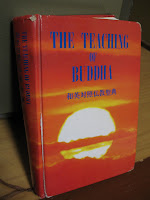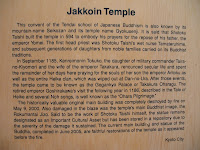 So, about a week later after Ohara, Erin knew about this annual national Kyudo event taking place in Kyoto at Sanjusangendo, one of my most favorite temples I've visited in Japan(I think I've been there four or five times now). This historic temple has been the site of this yearly archery event, where all of Japan's Kyudoist(practitioners of Japanese archery) come for a day-long competition and celebration of this ancient martial art.
So, about a week later after Ohara, Erin knew about this annual national Kyudo event taking place in Kyoto at Sanjusangendo, one of my most favorite temples I've visited in Japan(I think I've been there four or five times now). This historic temple has been the site of this yearly archery event, where all of Japan's Kyudoist(practitioners of Japanese archery) come for a day-long competition and celebration of this ancient martial art.Erin had studied Kyudo in Chicago, before we moved to Japan; so, she's got the experience and understanding of this subtle yet powerful martial art. She started her practice of Kyudo again here in Japan with our friend Doc, also a JET teacher. He, along with our Japanese friend Yoshi, came with us to enjoy this special event.
Kyudo is highly tied to the Japanese philosophical and spiritual practice of Zen, a mindful awareness of the present. There's much more that goes into Zen, but that should be enough to get the gist. Zen is practiced and perfected in not just Japanese martial arts such as Kyudo, Aikido, Judo, Kendo, and many others, but also in everyday "ceremonies" such as Ikebana Kado(the art of flower arranging), Sado(the art of preparing, presenting, and drinking tea), and Shodo(the art of Japanese calligraphy). In particular, Kyudo emphasizes the perfection of form and control through the practice of posture and a particular procedure of motions, after that, which is mastered in both mind and body, comes a moment of beauty and enlightenment, to be pursued with every draw of the bow. At least, that's how I see(even though I never tried myself). It's a very dedicated art, and often referred to as the "purest of all martial arts."



On this particular day, January 13, 2008, over two thousand Kyudo practitioners came from all over Japan to take part in the Toshiya Kyudo Competition, and annual New Year's event held at Sanjusangendo. It was a crisp, windy day, and the sun peaked out now and again through the clouds to warm up the crowds and competitors. Every Kyudoist was given just two shots, and the ages ranged from the old to the young. A row of nine or so archers would line up at the mark with their bows(yumi) and two arrows(ya). They'd all set up and when they were ready, would take their shots at the target, about 60 meters away. This day also coincided with the Japanese national holiday called Seijin no Hi, Coming of Age Day, which is the marked celebration for the young adults of Japan turning the legal age of 20, the age at which they are allowed to legally drink, smoke, and vote(in no particular order). So, at this event there were droves of young Japanese folks dressed to the nines in their best kimonos to shoot arrows and look good doin' it, celebrating their coming of age.




Erin and Doc ran into their Kyudo sensei(teacher) who was preparing to take his shots. The two girls in this picture are also students of the same teacher, and they study at the same Kyudo dojo where Doc and Erin were studying.
It was pretty crowded, so everyone was jocking to get a good look at the competitions going on. We also took some time to stroll through the wonderful temple of Sanjusangendo, and also to visit the outdoor food vendors for some hot goodies to warm us up. Here's our friend Yoshi eating the classic takoyaki, fried octopus filled balls of goodness. Really, they are very delicious! There were many other food vendors, which is quite typical for any Japanese matsuri(festival).






"Men and women take part in the Zen archery contest at Sanjusangendo. This extraordinary building, apart from being the longest wooden structure in the world at 118m (nearly 400ft) has inspired samurai to demonstrate their prowess since 1573. The Toshiya contest features over 2,000 experienced archers and young people who are celebrating their coming of age at the beginning of the new year. Competitors need to hit a target only 50 to 100cm in diameter (20–40in) 60m (200ft) away."- http://www.worldeventsguide.com/event.ehtml?o=1753

"The contest has its origins in the Edo period (1600-1867) when samurai warriors competed by shooting arrows down the 120-meter long, narrow hall. The contest, organized by the Kyoto Prefecture Archery Federation and the temple, is held each year in conjunction with the Coming-of-Age Day."- http://www.kyoto-np.co.jp/kp/topics/eng/2004jan/01-18.html

 This Taishoya Competition was a excellent experience and a wonderful way to observe a tradition of Japan that is uniquely Japanese. Sure, there's archery throughout the world and in countless cultures, used in hunting, war, competition, and showmanship(wasn't there a story about William Tell shooting an apple on the top of his son's head? whoops, that was a crossbow shot. None-the-less, look at the legend of Robin Hood, that Kostner was one hip shot!). But, like many things either adopted or originated here in Japan, the people and the culture strive for this impossible perfection; and on this day it was pursued through Kyudo. It is in the striving that beauty is glimpsed through the gestures and actions of a true master, and sought after by the students of any particular discipline. The look of concentration and determination that each and every Kyudoist wore on his and her face was focused, but calm, stoic but humble, and undeniably Japanese. This aspect of Japanese culture and life will always and forever amaze me.
This Taishoya Competition was a excellent experience and a wonderful way to observe a tradition of Japan that is uniquely Japanese. Sure, there's archery throughout the world and in countless cultures, used in hunting, war, competition, and showmanship(wasn't there a story about William Tell shooting an apple on the top of his son's head? whoops, that was a crossbow shot. None-the-less, look at the legend of Robin Hood, that Kostner was one hip shot!). But, like many things either adopted or originated here in Japan, the people and the culture strive for this impossible perfection; and on this day it was pursued through Kyudo. It is in the striving that beauty is glimpsed through the gestures and actions of a true master, and sought after by the students of any particular discipline. The look of concentration and determination that each and every Kyudoist wore on his and her face was focused, but calm, stoic but humble, and undeniably Japanese. This aspect of Japanese culture and life will always and forever amaze me.


In this shot here, I luckily captured this archer's arrow in mid-flight, just after we released. I didn't notice it until I got home, downloaded all my pics onto my computer, and got a closer look. In these last pics too, you can see just how long the bow is that's used in Kyudo.
As things were winding down, we left to get something to eat. And, on a spur of the moment, we decided to find a sento(bath house) that Erin and I had been to last summer to take a bath, relax, and warm ourselves after a day in the chilly winds. We found the neighborhood sento and soaked in the warm waters of the baths, as well as the heat of the sauna(my favorite since our trip to Thailand). Afterwards, we had planned to go to this great little Mexican joint Erin and I also discovered in the summer, though, it was closed, so we opted for some traditional Japanese ramen.

If you probably don't know(I know I sure didn't until I came here to Japan), that ramen in the States, you know, that cheap, prepackaged instant college food staple, is a mere glimpse of a shadow of what REAL ramen is like. Real ramen is served, as we had it here in Kyoto and elsewhere throughout Japan, in large bowls filled with the fresh, homemade, hand-cut noodles, that are drowned in a tasty broth(each broth is distinct depending on regional tastes and flavors, as well as the specialty of that particular ramen shop), some vegetables like bean sprouts, green onions, maybe daikon, and various types of meat or seafood, depending on what you order. It is the quintessential Japanese comfort food.
 For the complete set of the photos taken, check out my album on Facebook:
For the complete set of the photos taken, check out my album on Facebook:http://www.facebook.com/album


































